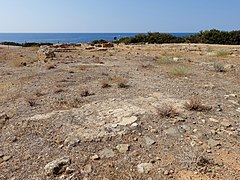Roman villa of Makrygialos
The Roman villa of Makrygialos ( Greek Ρωμαϊκή έπαυλη Μακρυγιαλού Romaiki epavli Makrygialou ) refers to an archaeological excavation site in the southeast of the Greek island of Crete . It is located in the municipality of Ierapetra of the Lasithi regional district on the western edge of the place Makrygialos ( Μακρυγιαλός ) on the Katovigli peninsula ( Κατωβίγλι ). The entrance to the fenced archaeological site is 50 meters southeast of the Ekklisia tis Kimiseos tis Theotokou ( Εκκλησία της Κοιμήσεως της Θεοτόκου 'Church of the Dormition of the Mother of God ').
history

The excavation site of the "Roman villa" is located 70 meters north of Kalamokanias beach ( Καλαμοκανιάς ) and 110 meters west of the port of Makrygialos at an altitude of about 15 meters . The site, recorded under the name Katovigli , was excavated from 1976 to 1980 by the Greek archaeologist Nikos Papadakis after the British John Pendlebury had already established the existence of a Roman settlement at this point in the 1930s . In 1937 a grave inscription from the 4th century was found here. The existence of the “Roman villa” goes back to the 1st century BC. Dated to the 3rd century AD.
In Roman times, a building stood on the 1500 m² area of the excavation, the rooms of which were grouped around an open inner courtyard. A large, luxuriously furnished room served as the lobby. At the entrance to the “villa” there was a mosaic floor with geometric and floral motifs. The walls and floors of the main rooms were clad or paved with marble slabs. In the south-eastern part of the "villa" there was a bath area ( balaneion ) with a 3.90 × 3.15 meter, horseshoe-shaped basin, the floor and steps of which were made of marble. A large mosaic with geometric patterns was found outside to the west of the pool. Open channels and closed pipes led water from cisterns into the Balaneion. In addition, the "villa" had a grave room with an embedded burial chamber.
The almost complete lack of finds within the architectural remains of the “Roman villa” points to a systematic looting of the excavation site, in the modern era or at the end of antiquity up to the Middle Ages. A larger-than-life marble head of the Roman emperor Hadrian recovered here is now in the archaeological museum of Sitia under inventory number 9003.
- Excavation site
literature
- Nikos Papadakis: Sitia: Fatherland of Myson and Kornaros . District Council of Sitia, Sitia 1983 (English).
Individual evidence
- ↑ The Minoan Villa of Makry Gialos. In Sitia, 2011, accessed October 10, 2016 .
- ↑ a b c Chr. Sofianos: Ναός Αγίου Πνεύματος στο Λιμνάκαρο . Greek Ministry of Culture, 2012, accessed October 10, 2016 (Greek).
- ^ Archaeological sites. Makrigialos Roman Villa. Porfyra's Island, accessed October 10, 2016 .
- ↑ Roman villa of Makri Gialos. Region of Crete, accessed October 10, 2016 .
- ^ Archaeological Sites in Sitia - Palekastro - Ierapetra: Makrigialos. (No longer available online.) Www.crete-today.com, archived from the original on October 6, 2016 ; accessed on October 10, 2016 (English). Info: The archive link was inserted automatically and has not yet been checked. Please check the original and archive link according to the instructions and then remove this notice.
- ^ Sara Paton, Rolf M. Schneider: Imperial Splendor in the Province: Imported Marble on Roman Crete . In: Angelos Chaniotis (Ed.): From Minoan Farmers to Roman Traders: Sidelights on the Economy of Ancient Crete . Franz Steiner, Stuttgart 1999, ISBN 3-515-07621-2 , pp. 288 (English, digitized version [accessed on April 28, 2017]).
Web links
- Makrygialos: Katovigli. In: Digital Crete: Archaeological Atlas of Crete. Foundation for Research and Technology-Hellas (FORTH), Institute for Mediterranean Studies(English).
- Chr. Sofianos: Ναός Αγίου Πνεύματος στο Λιμνάκαρο. Greek Ministry of Culture, 2012, accessed October 10, 2016 (Greek).
- Makry Gialos Roman Villa. Interkriti, accessed on October 10, 2016 .
- H. Eikamp, U. Kluge: Two ancient villas in Makrigialos (South Crete): Minoan and Roman house complexes. (PDF) Scientific Working Group Obertshausen-Mosbach, April 29, 2007, accessed on October 10, 2016 (547.91 KB).
Coordinates: 35 ° 2 ′ 11.1 ″ N , 25 ° 58 ′ 18.7 ″ E




